engine Citroen C4 PICASSO 2016 2.G Owner's Manual
[x] Cancel search | Manufacturer: CITROEN, Model Year: 2016, Model line: C4 PICASSO, Model: Citroen C4 PICASSO 2016 2.GPages: 527, PDF Size: 13.72 MB
Page 4 of 527
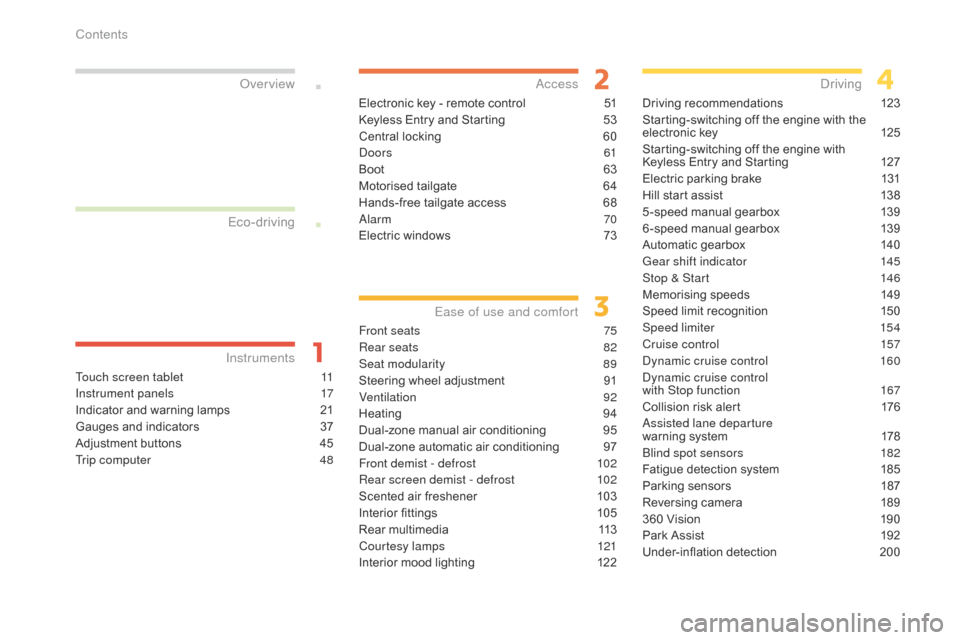
C4-Picasso-II_en_Chap00a_sommaire_ed01-2016
Touch screen tablet 11
Instrument panels
1
7
Indicator
and warning lamps
2
1
Gauges
and indicators
3
7
Adjustment
buttons
4
5
Trip computer
4
8
InstrumentsOver view
Electronic key - remote control 5
1
Keyless Entry and Starting
5
3
Central
locking
6
0
Doors
61
Boot
6
3
Motorised
tailgate
6
4
Hands-free
tailgate access
6
8
Alarm
70
Electric
windows
7
3
Access
Front seats 75
Rear seats
8
2
Seat modularity
8
9
Steering
wheel adjustment
9
1
Ventilation
92
Heating
9
4
Dual-zone
m
anual
a
ir
c
onditioning
9
5
Dual-zone
automatic air conditioning
9
7
Front demist - defrost
1
02
Rear screen demist - defrost
1
02
Scented
air freshener
1
03
Interior
fittings
1
05
Rear
multimedia
1
13
Courtesy lamps
1
21
Interior
mood lighting
1
22
Ease of use and comfort
Driving recommendations 1 23
Starting-switching off the engine with the
e
lectronic key
1
25
Starting-switching
off the engine with
K
eyless Entry and Starting
1
27
Electric
parking brake
1
31
Hill
start assist
1
38
5 -speed
manual gearbox
1
39
6 -speed
manual gearbox
1
39
Automatic
gearbox
1
40
Gear shift indicator
1
45
Stop & Start
1
46
Memorising
speeds
1
49
Speed
limit recognition
1
50
Speed limiter
1
54
Cruise control
1
57
Dynamic cruise control
1
60
Dynamic cruise control
with Stop function
1
67
Collision
risk alert
1
76
Assisted lane departure
warning
system
1
78
Blind spot sensors
1
82
Fatigue
detection system
1
85
Parking
sensors
1
87
Reversing
camera
1
89
360
Vision
1
90
Park
Assist
1
92
Under-inflation
d
etection
20
0
Driving
Eco-driving
Contents
Page 5 of 527
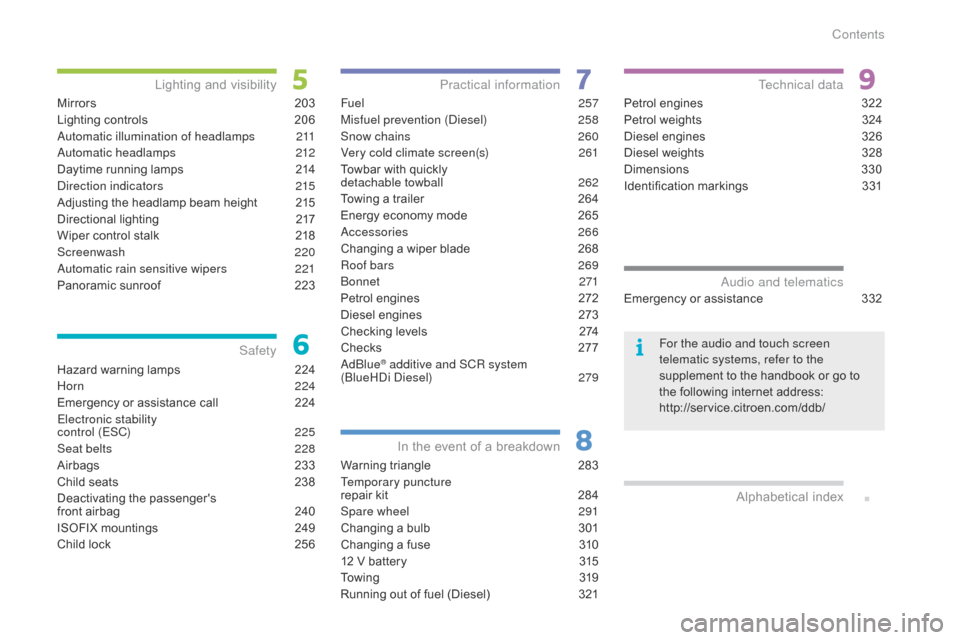
C4-Picasso-II_en_Chap00a_sommaire_ed01-2016
Hazard warning lamps 224
Horn
2
24
Emergency
or assistance call
2
24
Electronic stability
control (ESC)
2
25
Seat belts
2
28
Airbags
2
33
Child
seats
2
38
Deactivating
t
he
p
assenger's
f
ront airbag
2
40
ISOFIX
mountings
2
49
Child
lock
2
56
Safety
Fuel 257
Misfuel prevention (Diesel)
2
58
Snow chains
2
60
Very cold climate screen(s)
2
61
Towbar
with quickly
detachable towball
2
62
Towing
a trailer
2
64
Energy
economy mode
2
65
Accessories
266
Changing
a wiper blade
2
68
Roof bars
2
69
B o nnet
271
Petrol
engines
2
72
Diesel
engines
2
73
Checking
levels
2
74
Checks
2
77
AdBlue
® additive and SCR system
(BlueHDi Diesel) 2 79
Practical information
Warning triangle 2 83
Temporary puncture
repair
kit
2
84
Spare wheel
2
91
Changing
a bulb
3
01
Changing
a fuse
3
10
12
V battery
3
15
To w i n g
3
19
Running
out of fuel (Diesel)
3
21
In the event o f a b reakdown
Petrol engines 3 22
Petrol weights
3
24
Diesel
engines
3
26
Diesel
weights
3
28
Dimensions
3
30
Identification
ma
rkings
3
31
Technical data
Emergency or assistance 332Audio and telematics
Mirrors 203
Lighting controls
2
06
Automatic illumination of headlamps
2
11
Automatic headlamps
2
12
Daytime
running lamps
2
14
Direction indicators
2
15
Adjusting
the headlamp beam height
2
15
Directional
l
ighting
2
17
Wiper
control stalk
2
18
Screenwash
220
Automatic rain sensitive wipers
2
21
Panoramic
sunroof
2
23
Lighting and v isibility
Alphabetical
in
dex
For the audio and touch screen
telematic systems, refer to the
supplement to the handbook or go to
t
he following internet address:
http://service.citroen.com/ddb/
Contents
Page 10 of 527
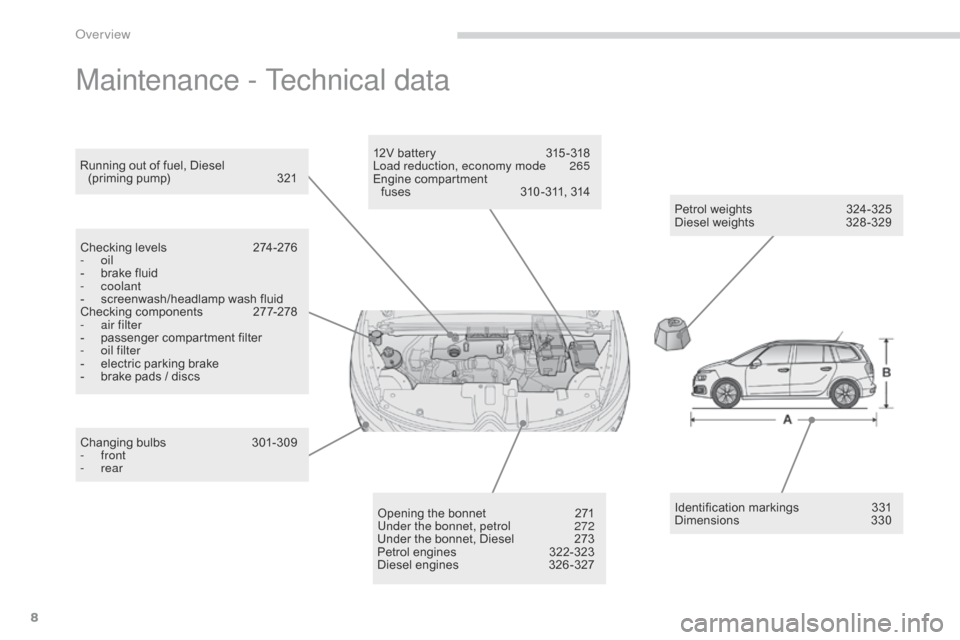
8
C4-Picasso-II_en_Chap00b_vue-ensemble_ed01-2016
Maintenance - Technical data
Petrol weights 324-325
Diesel weights 3 28 -329
Running
out
of
fuel,
Diesel
(priming
pump)
3
21
Checking
levels
2
74-276
-
oil
-
b
rake
fluid
-
coolant
-
s
creenwash/headlamp
wash
fluid
Checking
components
2
77-278
-
a
ir filter
-
p
assenger
c
ompartment
f
ilter
-
o
il filter
-
e
lectric
parking
brake
-
b
rake
pads
/
discs
Changing
bu
lbs
3
01-309
-
front
-
rear Opening
the
bonnet
2
71
Under the bonnet, petrol
2
72
Under
the
bonnet,
Diesel
2
73
Petrol
engines
3
22-323
Diesel
engines
3
26 -327 Identification
ma
rkings
3
31
Dimensions
3
30
12V
battery
3
15 -318
Load reduction, economy mode
26
5
Engine
c
ompartment
f
uses
31
0 - 311,
31
4
Over view
Page 11 of 527
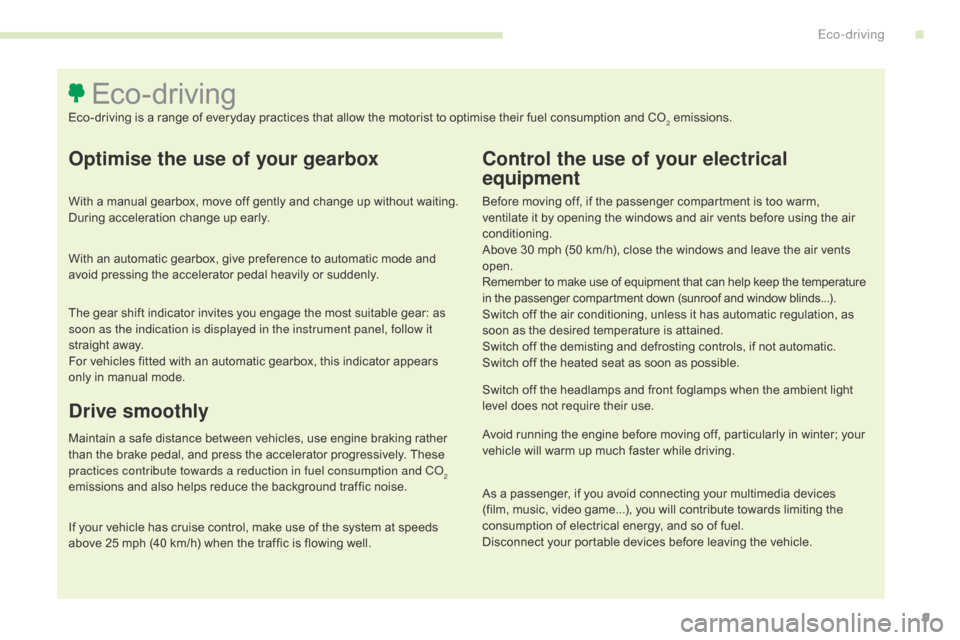
9
C4-Picasso-II_en_Chap00c_eco-conduite_ed01-2016
Optimise the use of your gearbox
With a manual gearbox, move off gently and change up without waiting. During acceleration change up early.
With
an automatic gearbox, give preference to automatic mode and
a
void pressing the accelerator pedal heavily or suddenly.
Control the use of your electrical
equipment
Before moving off, if the passenger compartment is too warm, ventilate it by opening the windows and air vents before using the air
c
onditioning.
Above
30 mph (50 km/h), close the windows and leave the air vents
ope
n.
Remember
to make use of equipment that can help keep the temperature
i
n the passenger compartment down (sunroof and window blinds...).
Switch
off the air conditioning, unless it has automatic regulation, as
s
oon as the desired temperature is attained.
Switch
off the demisting and defrosting controls, if not automatic.
Switch
off the heated seat as soon as possible.
Switch
off the headlamps and front foglamps when the ambient light
l
evel does not require their use.
Avoid
running the engine before moving off, particularly in winter; your
v
ehicle will warm up much faster while driving.
As
a passenger, if you avoid connecting your multimedia devices
(
film, music, video game...), you will contribute towards limiting the
c
onsumption of electrical energy, and so of fuel.
Disconnect
your portable devices before leaving the vehicle.
Eco-driving
Eco-driving is a range of everyday practices that allow the motorist to optimise their fuel consumption and CO2 emissions.
Drive smoothly
Maintain a safe distance between vehicles, use engine braking rather than the brake pedal, and press the accelerator progressively. These
p
ractices contribute towards a reduction in fuel consumption and CO
2
emissions
and
also
helps
reduce
the
background
traffic
noise.
If
your
vehicle
has
cruise
control,
make
use
of
the
system
at
speeds
a
bove
25
mph
(40
km/h)
when
the
traffic
is
flowing
well.
The
gear
shift
indicator
invites
you
engage
the
most
suitable
gear:
as
s
oon as the indication is displayed in the instrument panel, follow it
straight
away.
For
vehicles
fitted
with
an
automatic
gearbox,
this
indicator
appears
o
nly
in
manual
mode.
.
Eco-driving
Page 12 of 527
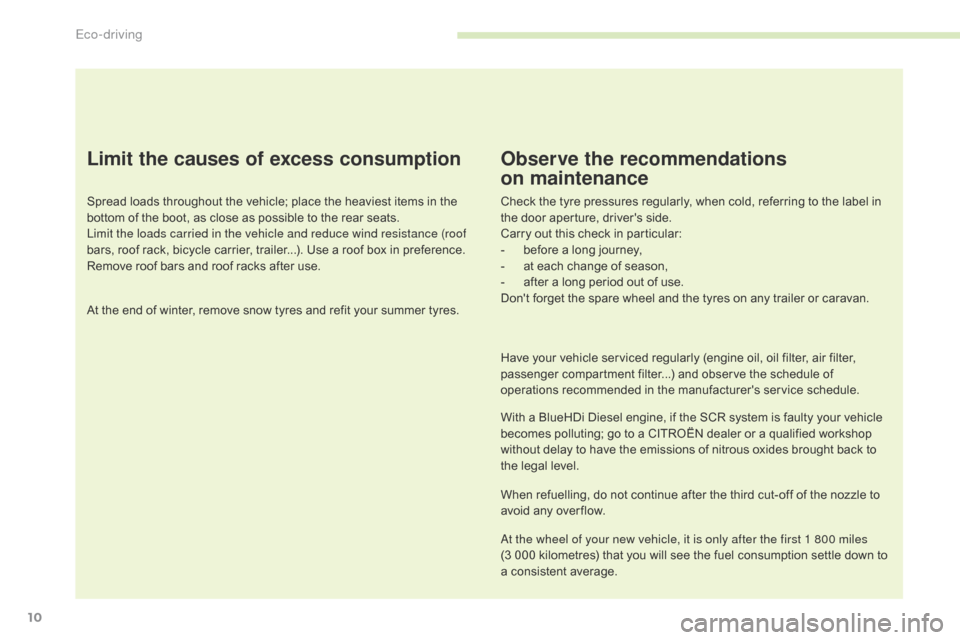
10
C4-Picasso-II_en_Chap00c_eco-conduite_ed01-2016
Limit the causes of excess consumption
Spread loads throughout the vehicle; place the heaviest items in the bottom of the boot, as close as possible to the rear seats.
Limit the loads carried in the vehicle and reduce wind resistance (roof
bars,
roof rack, bicycle carrier, trailer...). Use a roof box in preference.
Remove
roof bars and roof racks after use.
At
the end of winter, remove snow tyres and refit your summer tyres.
Observe the recommendations
on maintenance
Check the tyre pressures regularly, when cold, referring to the label in the door aperture, driver's side.
Carry
out this check in particular:
-
b
efore a long journey,
-
a
t each change of season,
-
a
fter a long period out of use.
Don't
forget the spare wheel and the tyres on any trailer or caravan.
Have
your vehicle serviced regularly (engine oil, oil filter, air filter,
p
assenger compartment filter...) and observe the schedule of
o
perations recommended in the manufacturer's service schedule.
With
a BlueHDi Diesel engine, if the SCR system is faulty your vehicle
b
ecomes polluting; go to a CITROËN dealer or a qualified workshop
w
ithout delay to have the emissions of nitrous oxides brought back to
t
he legal level.
When
refuelling, do not continue after the third cut-off of the nozzle to
a
void any over flow.
At the wheel of your new vehicle, it is only after the first 1 800 miles
(3 000
kilometres) that you will see the fuel consumption settle down to
a
consistent average.
Eco-driving
Page 19 of 527
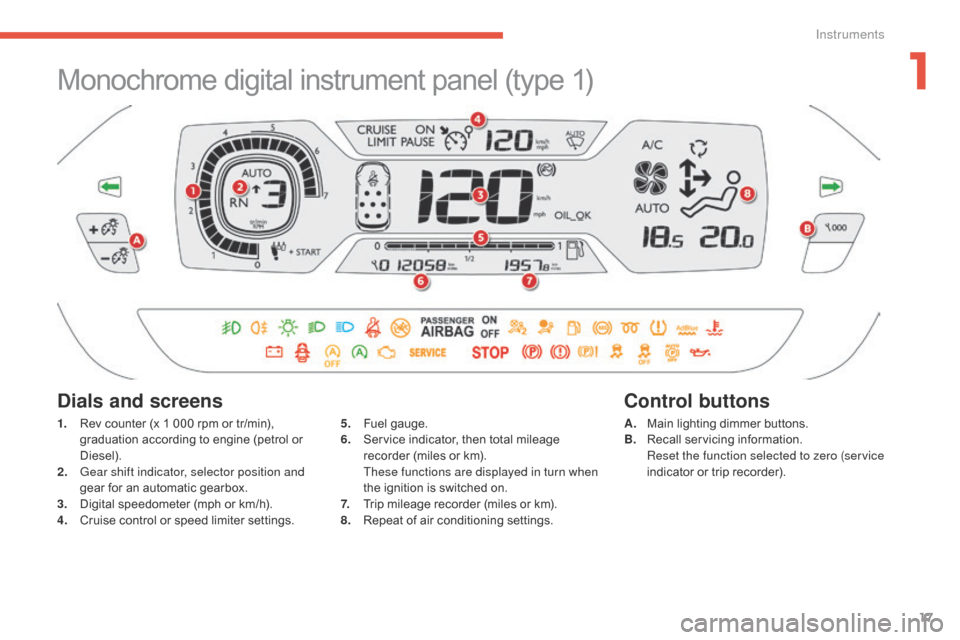
17
C4-Picasso-II_en_Chap01_instruments-bord_ed01-2016
Monochrome digital instrument panel (type 1)
1. Rev counter (x 1 000 rpm or tr/min), g
raduation according to engine (petrol or
D
iesel).
2.
G
ear shift indicator, selector position and
gear
for an automatic gearbox.
3.
D
igital speedometer (mph or km/h).
4.
C
ruise control or speed limiter settings.
Dials and screens
5. Fuel gauge.
6. S ervice indicator, then total mileage
r
ecorder (miles or km).
T
hese functions are displayed in turn when
the
ignition is switched on.
7.
T
rip mileage recorder (miles or km).
8.
R
epeat of air conditioning settings.A. M
ain lighting dimmer buttons.
B. R ecall servicing information.
R
eset the function selected to zero (service
indicator
or trip recorder).
Control buttons
1
Instruments
Page 23 of 527
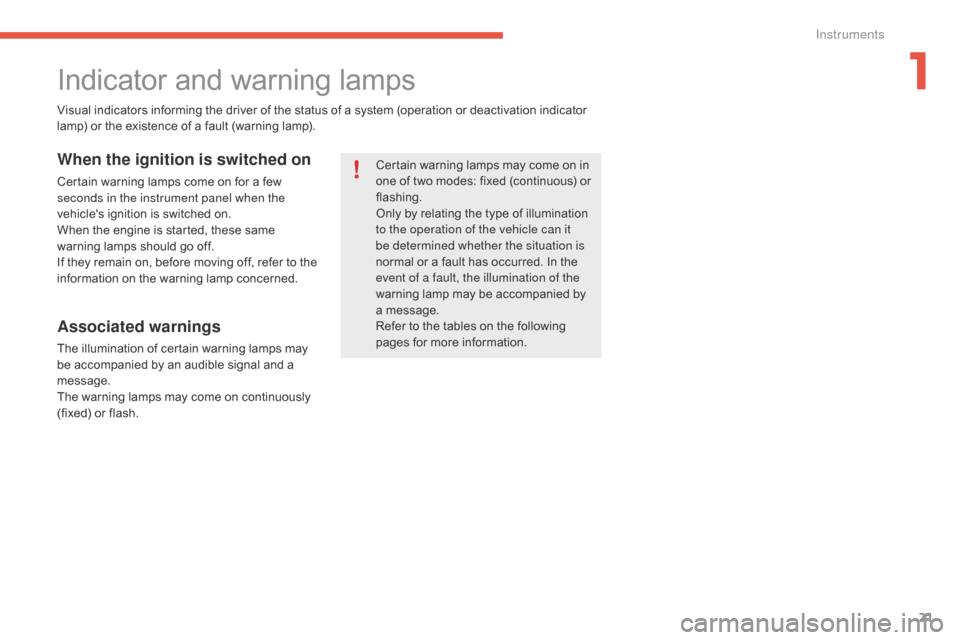
21
C4-Picasso-II_en_Chap01_instruments-bord_ed01-2016
Indicator and warning lamps
Certain warning lamps may come on in one of two modes: fixed (continuous) or
f
lashing.
Only
by relating the type of illumination
t
o the operation of the vehicle can it
be determined whether the situation is
normal
or a fault has occurred. In the
e
vent of a fault, the illumination of the
warning
lamp may be accompanied by
a
message.
Refer
to the tables on the following
p
ages
f
or
m
ore
i
nformation.
Visual
indicators
informing
the
driver
of
the
status
of
a
system (operation or deactivation indicator
l
amp)
or
the
existence
of
a
fault
(warning
lamp).When the ignition is switched on
Certain warning lamps come on for a few s
econds in the instrument panel when the
vehicle's
ignition is switched on.
When
the engine is started, these same
w
arning lamps should go off.
If
they remain on, before moving off, refer to the
i
nformation on the warning lamp concerned.
Associated warnings
The illumination of certain warning lamps may be accompanied by an audible signal and a
m
essage.
The
warning lamps may come on continuously
(
fixed) or flash.
1
Instruments
Page 26 of 527
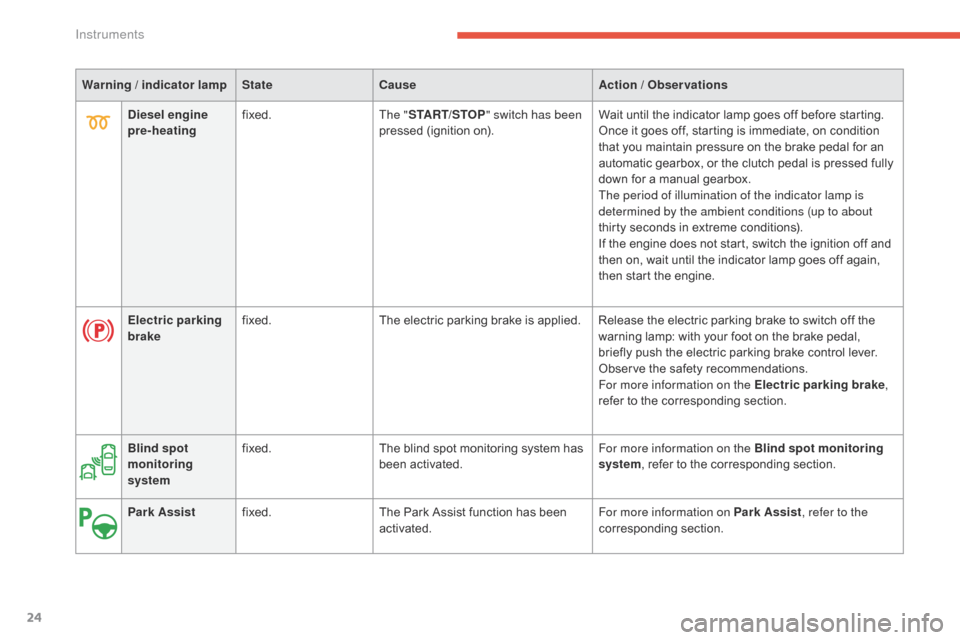
24
C4-Picasso-II_en_Chap01_instruments-bord_ed01-2016
Warning / indicator lampStateCause Action / Observations
Electric parking
brake fixed.
The
electric parking brake is applied. Release the electric parking brake to switch off the
w
arning lamp: with your foot on the brake pedal,
b
riefly push the electric parking brake control lever.
Observe
the safety recommendations.
For more information on the Electric parking brake ,
refer
to the corresponding section.
Diesel engine
pre-heating
fixed.
The "START/STOP " switch has been
pressed
(ignition on).Wait
until the indicator lamp goes off before starting.
Once
it goes off, starting is immediate, on condition
t
hat you maintain pressure on the brake pedal for an
a
utomatic gearbox, or the clutch pedal is pressed fully
d
own for a manual gearbox.
The period of illumination of the indicator lamp is
determined by the ambient conditions (up to about
thirty
seconds in extreme conditions).
If
the engine does not start, switch the ignition off and
t
hen on, wait until the indicator lamp goes off again,
t
hen start the engine.
Blind spot
monitoring
system fixed.
The
blind spot monitoring system has
b
een activated.For more information on the Blind spot monitoring
system,
refer to the corresponding section.
Park Assist fixed. The
Park Assist function has been
a
ctivated.For more information on Park Assist
, refer to the
corresponding
s
ection.
Instruments
Page 27 of 527
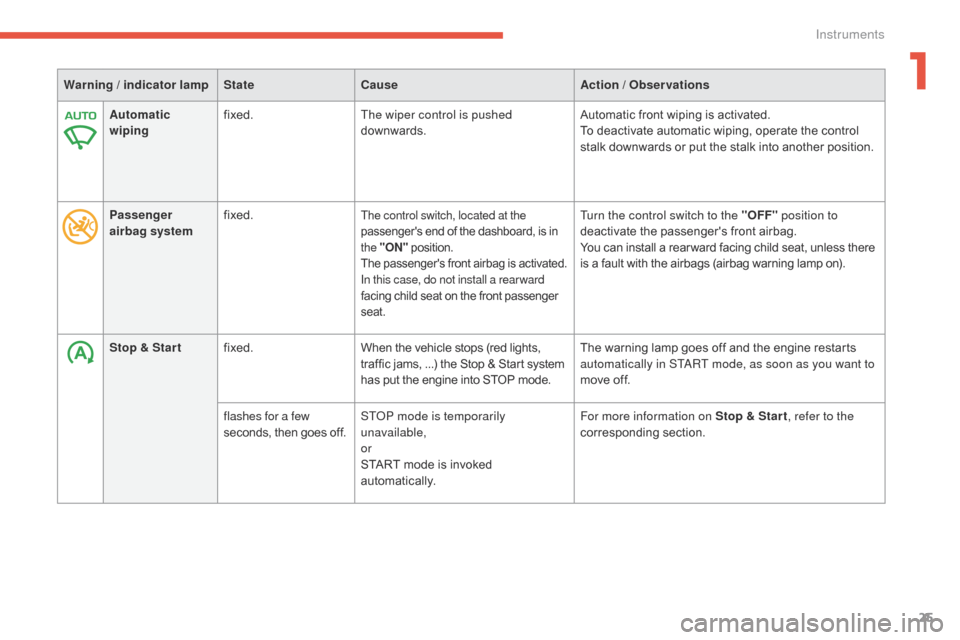
25
C4-Picasso-II_en_Chap01_instruments-bord_ed01-2016
Warning / indicator lampStateCause Action / Observations
Automatic
wiping fixed.
The wiper control is pushed
downwards. Automatic
front wiping is activated.
To
deactivate automatic wiping, operate the control
s
talk downwards or put the stalk into another position.
Passenger
airbag system fixed.
The control switch, located at the
passenger's
end of the dashboard, is in t
he "ON "
p
osition.
The
p
assenger's
f
ront
a
irbag
i
s
a
ctivated.
In this case, do not install a rear ward
facing
child seat on the front passenger
sea
t.Turn the control switch to the "OFF " position to
deactivate the passenger's front airbag.
You
can install a rear ward facing child seat, unless there
i
s a fault with the airbags (airbag warning lamp on).
Stop & Star t fixed. When
the
vehicle
stops
(red
lights,
t
raffic
jams,
...)
the
Stop
&
Start
system
h
as
put
the
engine
into
STOP
mode. The
warning lamp goes off and the engine restarts
a
utomatically in START mode, as soon as you want to
move
off.
flashes for a few
seconds,
then
goes
off. STOP mode is temporarily
unavailable,
or
START
mode
is
invoked
au
tomatically. For more information on Stop & Star t
, refer to the
corresponding
s
ection.
1
Instruments
Page 28 of 527
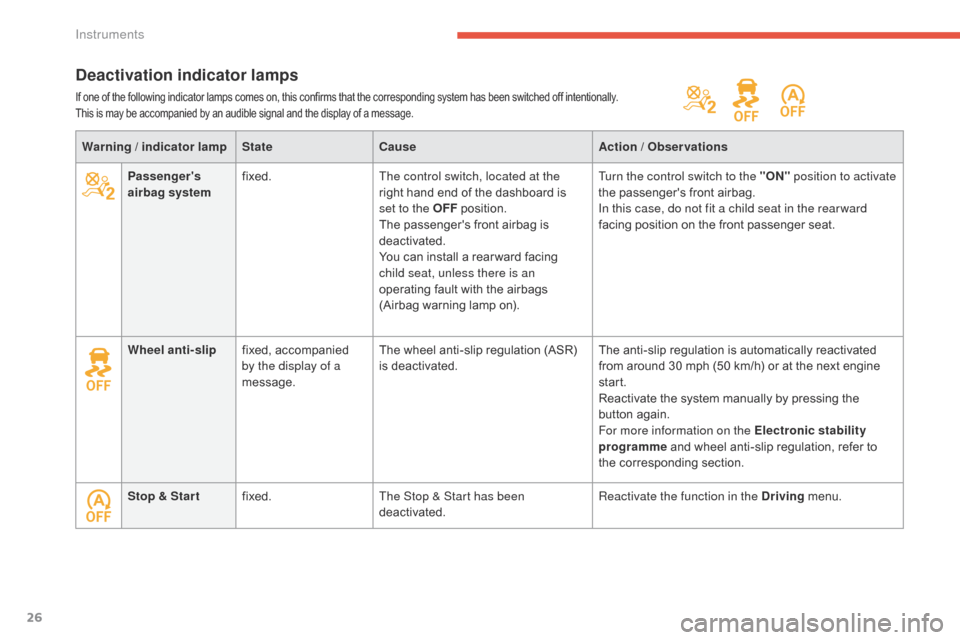
26
C4-Picasso-II_en_Chap01_instruments-bord_ed01-2016
Warning / indicator lampStateCause Action / Observations
Passenger's
airbag system fixed.
The control switch, located at the
right
hand end of the dashboard is
s
et to the OFF
p
osition.
The
passenger's front airbag is
d
eactivated.
You
can install a rear ward facing
c
hild seat, unless there is an
operating
fault with the airbags
(
Airbag warning lamp on).Turn the control switch to the "ON"
position to activate
the
passenger's front airbag.
In this case, do not fit a child seat in the rear ward
facing
position on the front passenger seat.
Wheel anti-slip fixed,
a
ccompanied
b
y the display of a
message. The
wheel anti-slip regulation (ASR)
i
s
d
eactivated.The
anti-slip regulation is automatically reactivated
f
rom around 30 mph (50 km/h) or at the next engine
st
art.
Reactivate
the system manually by pressing the
bu
tton
ag
ain.
For more information on the Electronic stability
programme
and wheel anti-slip regulation, refer to
t
he corresponding section.
Stop & Star t fixed. The Stop & Start
has been
deactivated. Reactivate the function in the Driving
menu.
Deactivation indicator lamps
If one of the following indicator lamps comes on, this confirms that the corresponding system has been switched off intentionally.
T his is may be accompanied by an audible signal and the display of a message.
Instruments